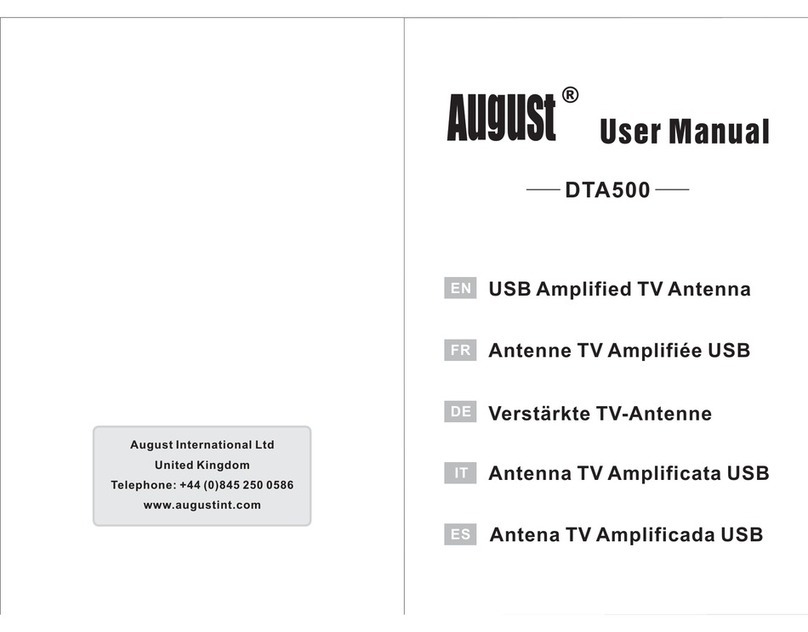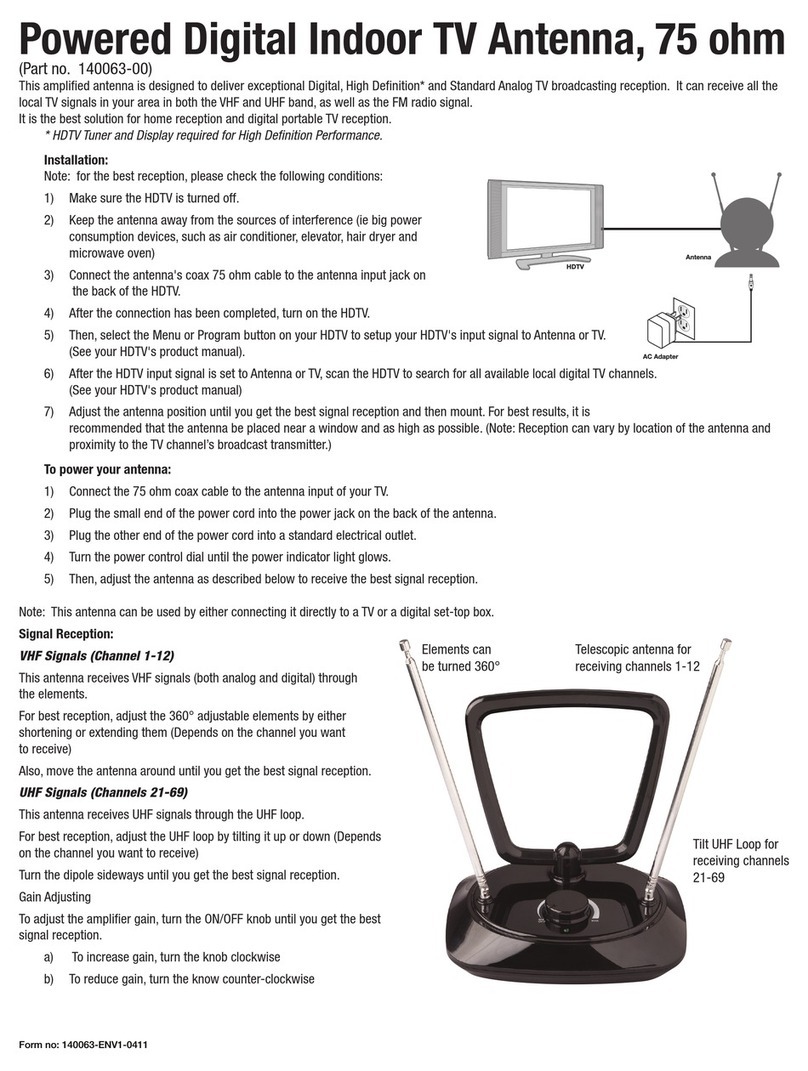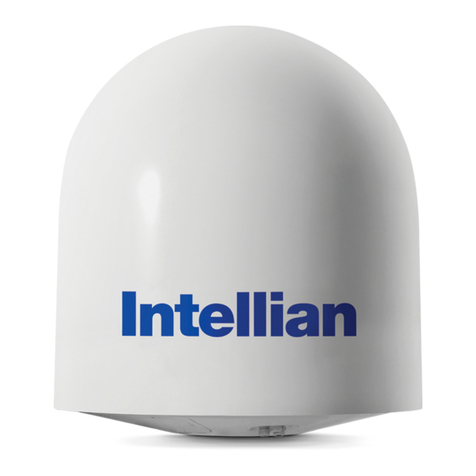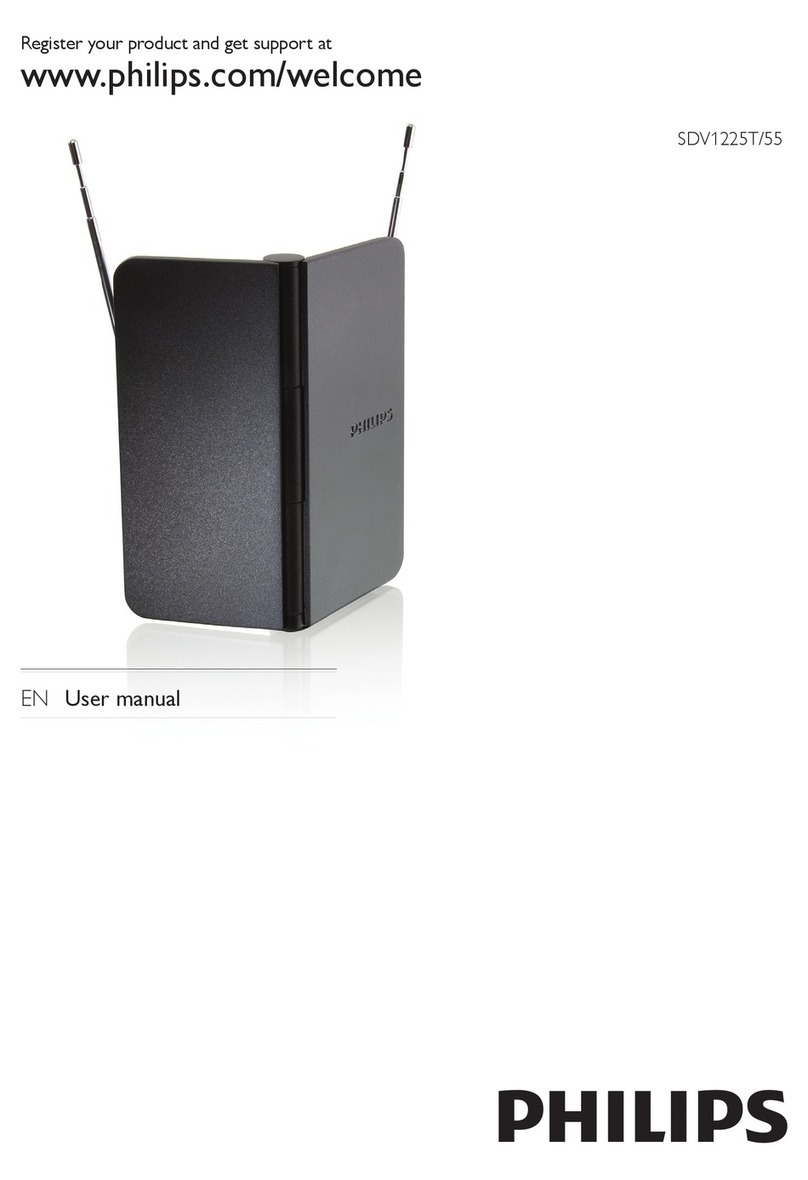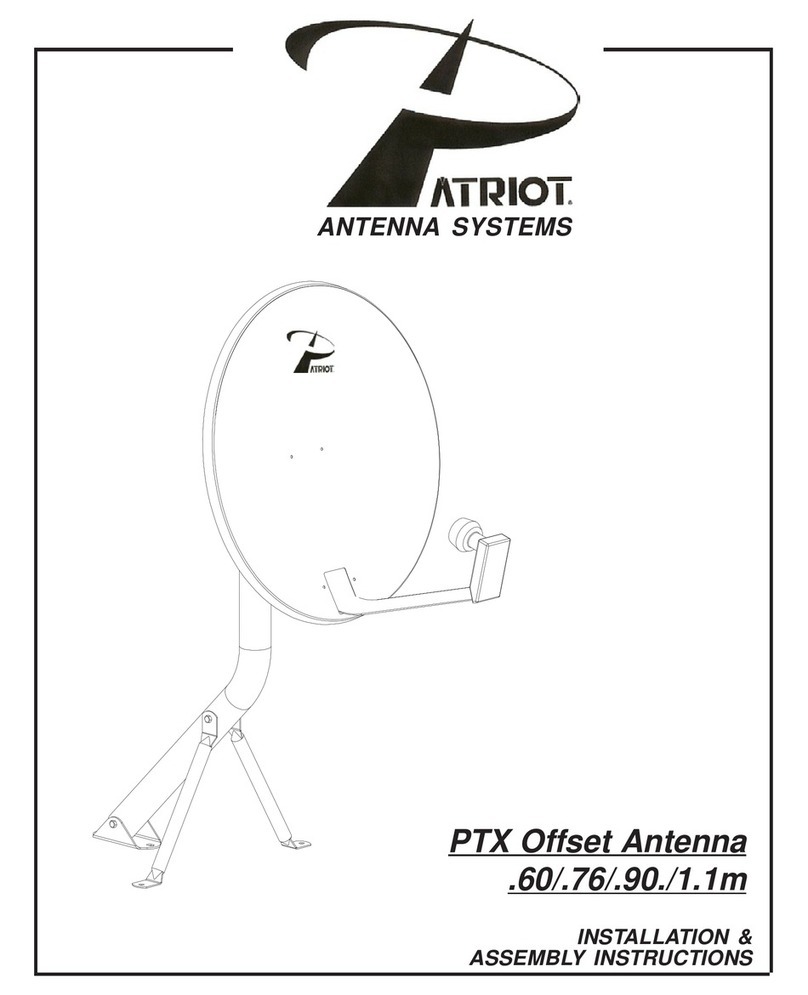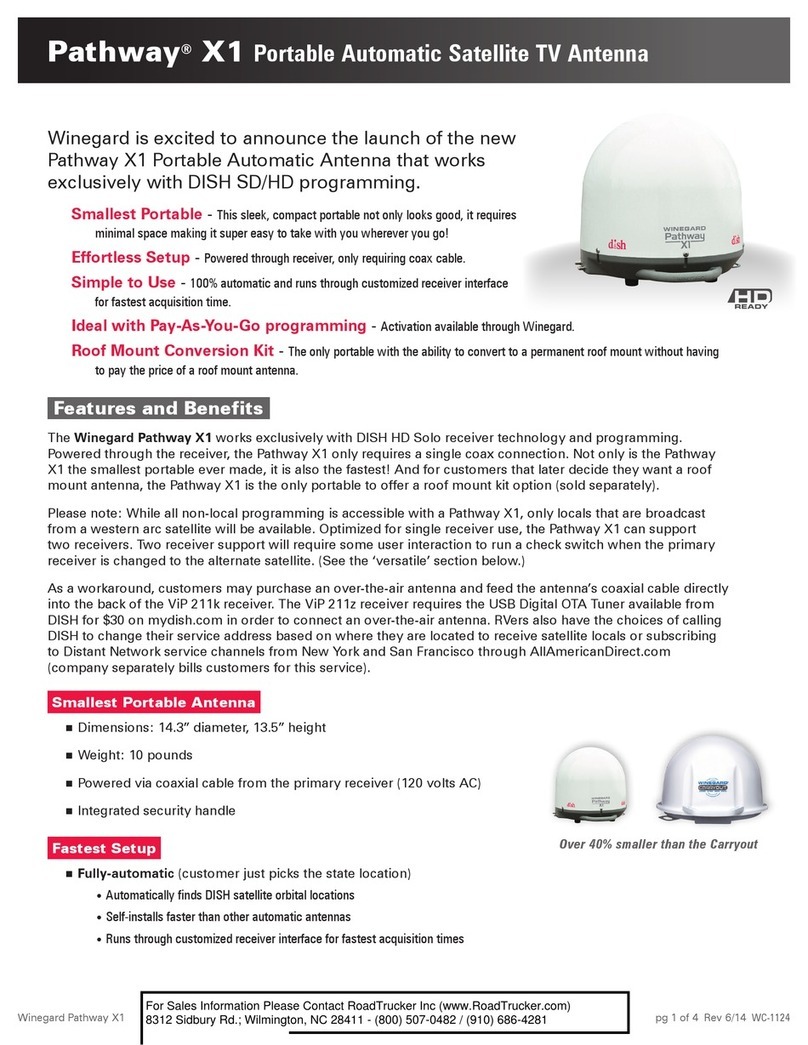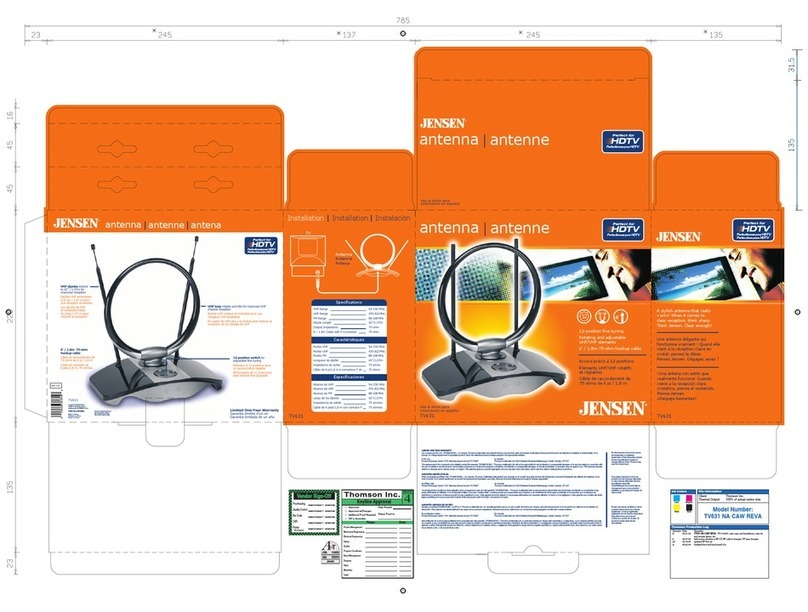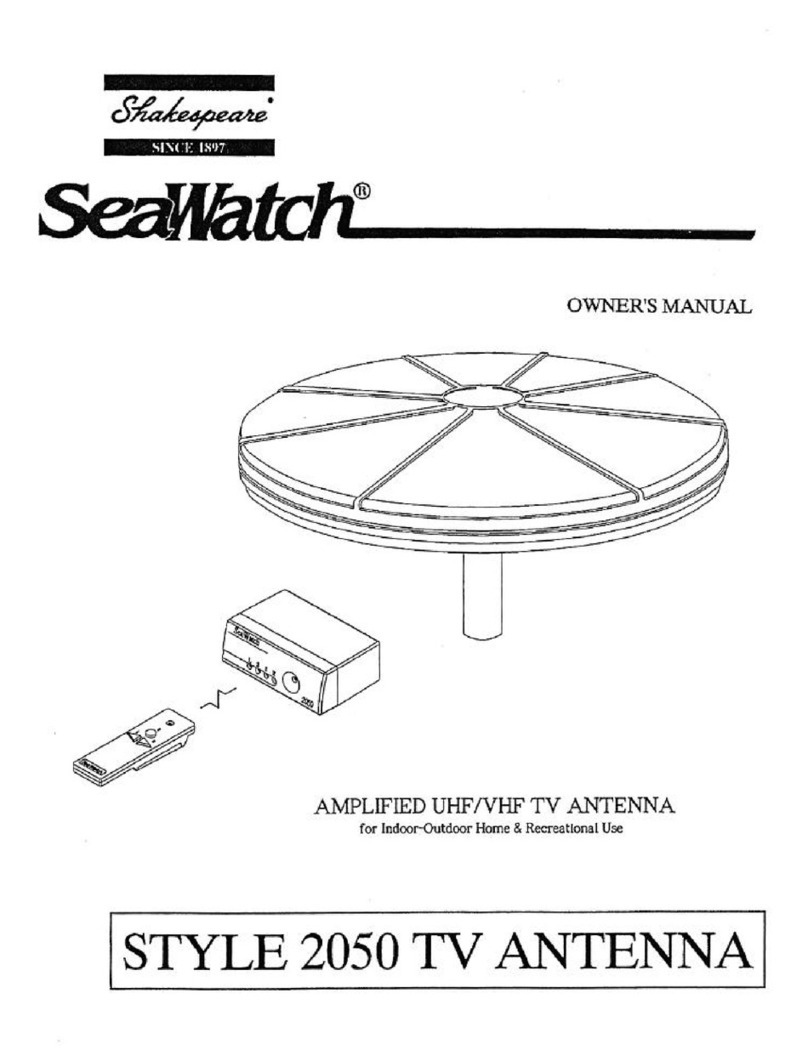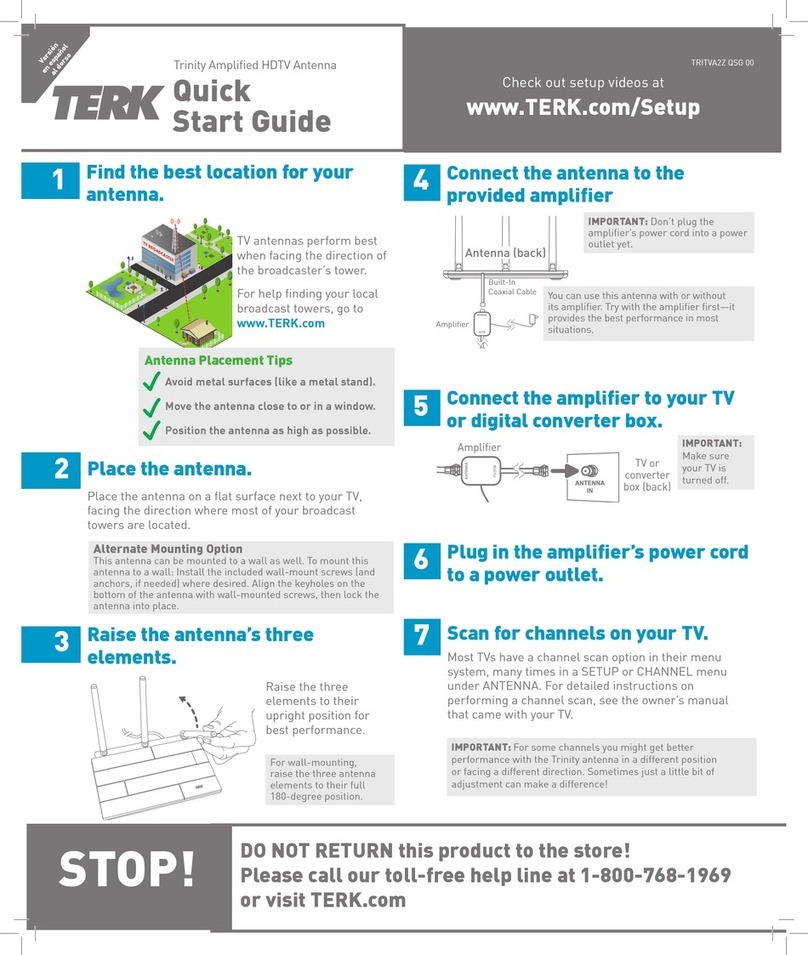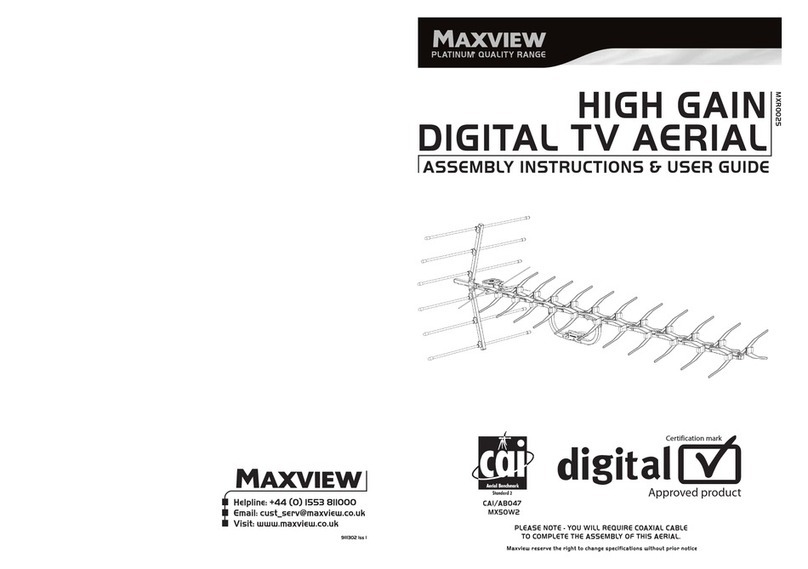Channel Master Advantage 3016 User manual

1. Si la antena tiene un 2 - o 3-sección crossarm pluma, reunir las secciones
witln tornillos y tuercas de mariposa. (Ver Fig. 1) 3-para la sección de
antenas, reunirse con los elementos de corto al frente de la antena y
los elementos Iong a la parte trasera de la antena. Cuando el montaje,
empuje la parte delantera o posterior de las secciones en el centro de la
sección con la ranura en la parte delantera o trasera secciones empujado
contra el remache, con el aislante al centro de la sección. Esto Iine hasta
los agujeros para el tornillo y tuerca mariposa.
2. Ali abrir elementos de la antena. NOTA: Los elementos de esta antena
está firmemente remachadas. Para evitar que se doble, mientras que
la apertura de los elementos, los elementos de agarre cerca de los
remaches. (Ver Figs. 2 y 3)
3. Swing gradual varillas (remachadas a la sección centro) en la posición
en la primera sección y segura con tuercas de mariposa. (Véase la fig. 4)
NOTA: No conectar cable o transmisión balun a estos puntos. Transmisión
de alambre o balun se adjuntan a la parte inferior de las terminales de
dipolo plegado UHF, como se muestra en el paso 5.
4. Standout hilo en el orificio en Iower reflector crossarm. (Ver Fig. 5.)
5. Conecte el alambre de transmisión (o balun, si la instalación coaxial) para
aprovechar el despegue terminales en la parte inferior de la dipolo UHF,
como se muestra en la fig. 6 (o 6A si un tornillo dipolo recto UHF).
6. Fije la antena al mástil utilizando U-perno de montaje como se muestra
en la Figs, 7 y 8.
7. Si la antena tiene auge llaves, seguro que el mástil debajo de la antena
como se muestra en la fig. 9. (Asegúrese de que el principal crossarm
recta al apretar los pernos en U nueces asegurar el auge de tirantes).
MONTAJE DE ANTENA
Standout
(sold separately)
HACIA LA ESTACIÓN
TRANSMISORA
HACIA LA ESTACIÓN
TRANSMISORA
www.channelmaster.com
1.866.430.1307 | 1.919.934.7078 | techsupport@channelmaster.com
©2009 Channel Master. Tempe AZ USA.
Pub CM.INST.3016_3018_3020.20090413
Especificaciones sujetas a cambio.
Todos los derechos reservados.
3
HIGH-
DEFINITION TELEVISION
ADVANTAGE
ADVANTAGE
MEDIUM AND LONG RANGE TV ANTENNAS
MEDIUM AND LONG RANGE TV ANTENNAS
HD DIGITAL / VHF / UHF / FM
HD DIGITAL / VHF / UHF / FM
Up to
60
60
Miles
Best for
LONG RANGE
3018
Models
3016, 3018
and 3020
INSTALLATION INSTRUCTIONS
INSTALLATION INSTRUCTIONS
3016
3020
Up to
100
100
Miles
Best for
LONG RANGE
Up to
45
45
Miles
Best for
MEDIUM RANGE
www.channelmaster.com
WARNING: Installation of this product near
power lines is DANGEROUS! For your safety, read
the enclosed “DANGER” booklet before beginning
your installation.

1
A. INSTALACIÓN DE HERRAMIENTAS
ÚTILES
• Grandes y pequeños destornilladores cuchilla
• Llave ajustable
• Cortadores de cable
• Alicates
B. DONDE MONTAR LA ANTENA
La antena se puede montar en la chimenea o bien,
la raíz o en una pared exterior o en un ático. Elija
el método que mejor se adapte a su situación
particular.
C. LÍNEA DE TRANSMISIÓN
75 Ohm cable coaxial tiene una vida Ionger-span
de 300 Ohm twinlead cable y no se ve afectada
por el contacto con el metal o la humedad. Para
instalar el cable coaxial, empezar por conectar
la antena extremo del cable a la antena balun
(suministrado con la antena). Conecte la entrada
de los cables a la antena balun terminales, y,
después, el cable coaxial a través de un standout
montado en el mástil. Esto evitará que el peso de
la Iine tirando de las conexiones de la antena.
D. PROTECCIÓN CONTRA RAYOS
El mástil y la transmisión Iine debe Iightning a tierra
para protección. Ejecutar un # 8 (o mayor), de
aluminio o cobre de un perno en el mástil o de su
base, hasta un 8 ‘vara de tierra. Mantenga el Iine
a un respetable distancia del cable de transmisión
de señal para evitar interferencias. Un bloque
de tierra coaxial (Channel Master Modelo 3274),
debe estar conectado a la antena de transmisión
de cable en el punto en que entra en la casa.
E. ENCAMINADA HACIA SU ANTENA
TRANSMITE LA ESTACIÓN
Una vez que la antena se haya completado la
instalación, encienda su televisor y tener un ayudante
observar la recepción. En el techo, el U-Ioosen
tuercas y pernos a su vez la antena hasta obtener la
mejor recepción. Una vez que esto se logra, apriete
los pernos en U nueces segura.
NOTA: i las emisoras se encuentran en distintas
direcciones, necesitará una antena de los
rotadores. Esto le permitirá girar la antena y
estaciones aisladas de identificar desde el
interior de su hogar. (Para más información sobre
rotadores, visite www.channelmaster.com.)
Find the installation you plan to make on the
following pages - READ THE INSTRUCTIONS
FOR ASSEMBLING THE ANTENNA AND THE
INSTALLATION BEFORE YOU START THE
ACTUAL WORK!
Encuentra la instalación va a hacer en las páginas
siguientes - LEA LAS INSTRUCCIONES DE
MONTAJE DE LA ANTENA Y LA INSTALACIÓN
antes de comenzar el trabajo real!
Visite a su distribuidor local o nuestro sitio web
disponible para monturas y accesorios que usted
necesita para su instalación.
Desde este punto, el resto de la coaxial pueden
ser grabadas para el mástil.
CONSEJOS DE INSTALACIÓN
ATTIC MOUNT ROOF MOUNT
(Using Guy Wire) CHIMNEY MOUNT WALL MOUNT TRIPOD
2
IMPORTANT SAFEGUARDS
• Remember, when working on a roof, use two adults.
• Never walk on a composition roof in cold weather.
• Wear sneakers or crepe soles, and use a safety rope.
• Always watch for power lines.
A. ATTIC MOUNT
Using a roof mount, attach a short piece of mast to a
convenient roof rafter. Attach and aim the antenna in
the same manner as outlined for outdoor installations.
NOTE: Antennas should not be installed in an attic if the
roof or walls are metal or are lined with foil backed insulation.
B. ROOF MOUNT
Used on peaked or flat roofs.
Suggested Height Limit: 10 feet above roof top.
Using a roof mount, connect the mast with guy ring and
guy wires attached, to the mount. Use three or four guy
wires, equally spaced around the mast, and anchor
the guy wires to the roof or eaves with eyebolts. The
guy ring should be clamped approximately one (1) foot
below the antenna, Use roofing compound around the
base of the mount, screws and eyebolts to seal against
moisture. After the installation has been completed,
mount the extra WARNING LABEL supplied with the
antenna hardware to the mast at EYE LEVEL!
C. CHIMNEY MOUNTING
Suggested Height Limit: 10 feet above rooftop.
First, check your chimney thoroughly for stability
to make sure that it is strong enough to support the
antenna during severe winds. Do not use a chimney
that has loose bricks or mortar. Install the upper bracket
just below the top course of bricks and the lower bracket
at least 2 1/2 feet below the top bracket. (For maximum
strength, space the brackets as far apart as possible.)
After the installation has been completed, mount the
extra WARNING LABEL supplied with the antenna
hardware to the mast at EYE LEVEL!
D. WALL MOUNT
Suggested Height Limit: 10 feet above rooftop.
If the roof overhang is not excessive, the side of the
house can be used for mounting. If a wall mounted
installation is done from the ground up, use a ground
mount with a “spike” at the ground. Position the wall
brackets over a stud if possible; one above the other
and space a minimum of three feet (3) apart. For metal
siding, mark mounting holes, then drill pilot holes through
the siding for mounting screws. If you use a 2-piece
mast, assemble the pieces as shown, making sure that
they are properly locked together. Split between masts
should be between the two (2) wall brackets, After
the installation has been completed, mount the extra
WARNING LABEL supplied with the antenna hardware
to the mast at EYE LEVEL!
E. TRIPOD MOUNT
Use on peaked or flat roofs.
Suggested Height Limit: 10 feet above roof top.
The tripod mount can be mounted to any style roof by
adjusting the bracket on the center leg. Insert the mast
into the tripod mount and place the mount with legs over
the roof rafters. Make sure the mast is vertical. Remove
the protective covering from one side of the three (3)
pitch pads and place under the base of each tripod leg
with the tacky side towards the roof. Secure the tripod
mount to the roof using lag screws. After the installation
has been completed, mount the extra WARNINGLABEL
supplied with the antenna hardware to the mast at
EYE LEVEL!
F. ANTENNA REMOVAL
Removal of your antenna should be exactly in reverse
of the installation instructions. For your own safety,
please follow the instructions for installing the antenna
starting with the last step first. This is the only way to
safely remove your antenna.
INSTALLATION LOCATIONS

1. If the antenna has a 2- or 3-section crossarm boom, assemble the
sections witln screws and wing nuts. (See Fig. 1) For 3-section antennas,
assemble with the short elements to the front of antenna and the Iong
elements to the rear of antenna. When assembling, push the front or rear
sections into the center section with the slot in the front or rear sections
pushed against the rivet, holding the insulator to the center section.
This will Iine up the holes for the screw and wing nut.
2. Open alI elements on the antenna. NOTE: The elements on this antenna
are tightly riveted. To avoid bending the elements while opening, grip the
elements near the rivets. (See Figs. 2 & 3)
3. Swing phasing rods (riveted to center section) into position on the front
section and secure with wing nuts. (See Fig. 4) NOTE: Do not attach
transmission wire or balun to these points. Transmission wire or balun
are attached to the bottom terminals of the folded UHF dipole as shown
in Step 5.
4. Thread standout into hole provided in Iower reflector crossarm. (See Fig. 5)
5. Attach transmission wire (or balun, if coax installation) to tap-off terminals
at the bottom of the UHF dipole, as shown in Fig. 6 (or 6A if a straight UHF
screw dipole).
6. Fasten antenna to mast using U-bolt assembly as shown in Figs, 7 & 8.
7. If the antenna has boom braces, secure them to the mast below the
antenna as shown in Fig. 9. (Make sure the main crossarm is straight
when tightening U-bolt nuts securing the boom braces.)
ANTENNA ASSEMBLY
Standout
(sold separately)
www.channelmaster.com
1.866.430.1307 | 1.919.934.7078 | techsupport@channelmaster.com
©2009 Channel Master. Tempe AZ USA.
Pub CM.INST.3016_3018_3020.20090413
Specifications subject to change.
All rights reserved.
3
HIGH-
DEFINITION TELEVISION
ADVANTAGE
ADVANTAGE
MEDIANO Y LARGO ALCANCE ANTENAS DE TELEVISIÓN
MEDIANO Y LARGO ALCANCE ANTENAS DE TELEVISIÓN
HD DIGITAL / VHF / UHF / FM
HD DIGITAL / VHF / UHF / FM
Hasta
60
60
Millas
mejor para
LARGA DISTANCIA
3018
Modelos
3016, 3018
and 3020
INSTRUCCIONES DE INSTALACIÓN
INSTRUCCIONES DE INSTALACIÓN
3016
3020
Hasta
100
100
Millas
mejor para
LARGA DISTANCIA
Hasta
45
45
Millas
mejor para
MEDIANO DISTANCIA
www.channelmaster.com
ADVERTENCIA: Instalar este producto cerca
de líneas eléctricas es PELIGROSO! Por su
seguridad, lea el folleto incluido antes de empezar
su instalación.

1
A. USEFUL INSTALLATION TOOLS
• Large and small blade screwdrivers
• Adjustable Wrench
• Wire Cutters
• Pliers
B. WHERE TO MOUNT YOUR
ANTENNA
Your antenna can be mounted on either the
chimney, the root or on an outside wall or in an
attic. Choose the method that best suits your
particular location.
C. TRANSMISSION LINE
75 Ohm coaxial cable has a Ionger Iife-span than
300 Ohm twinlead cable and is unaffected by
contact with metal or moisture. To install coaxial
cable, begin by connecting the antenna end of the
cable to the antenna balun (supplied with antenna).
Attach the input wires of the balun to the antenna
terminals, Next, run the coaxial cable through a
standout mounted on the mast. This will prevent
the weight of the Iine from pulling on the antenna
connections.
D. LIGHTNING PROTECTION
The mast and transmission Iine should be grounded
for Iightning protection. Run a #8 (or larger),
aluminum or copper wire from a bolt on the mast or
its base, down to a 8’ ground rod. Keep the Iine at
a respectable distance from your transmission wire
to prevent signal interference. A coaxial grounding
block (Channel Master Model 3274), should be
connected to the antenna transmission wire at the
point where it enters the house.
E. AIMING YOUR ANTENNA TOWARD
THE TRANSMITTING STATION
Once the antenna installation is completed, turn your
TV set on and have an assistant observe the reception.
On the roof, Ioosen the U-bolt nuts and turn the
antenna until you get the best reception. Once this
is accomplished, tighten U-bolts nuts securely,
NOTE: If broadcast stations are in different
directions, you will need an antenna rotator.
This will allow you to rotate the antenna and
pinpoint individual stations from inside your home.
(For more information on rotators, visit www.
channelmaster.com.)
Find the installation you plan to make on the
following pages - READ THE INSTRUCTIONS
FOR ASSEMBLING THE ANTENNA AND THE
INSTALLATION BEFORE YOU START THE
ACTUAL WORK!
Visit your local retailer or our website for available
mounts and accessories you’ll need for your
installation.
From this point, the rest of the coax may be taped
to the mast.
INSTALLATION TIPS ÁTICO
DE MONTAJE TECHO DE MONTAJE
(Uso de Guy Wire) CHIMENEA MONTE DE MONTAJE
EN PARED TRÍPOD
Tejado monte
Mástil
Cable coaxial
Snap-on destacan
Tornillo de las destacan
Alambre guy
Anillo de sujeción y guy
Cáncamos
Chimenea monte correas
Chimenea monte
Monte terreno
De montaje en pared
Trípode monte
Pitch blocs
Tirafondos
2
IMPORTANTES MEDIDAS DE SEGURIDAD
• Recuerde, cuando se trabaja en un techo, utilice dos adultos.
• Nunca camine sobre el techo de una composición en frío.
• Use zapatillas o crepé soles, y utilizar una cuerda de seguridad.
• Siempre atentos a las líneas eléctricas.
A. ÁTICO MONTE
El uso de un techo de montaje, adjuntar un breve trozo de
mástil a una viga del techo. Conecte la antena y el objetivo
de la misma manera como se indica para instalaciones al
aire libre.
NOTA: Las antenas no deben ser instalados en un ático si el
techo o las paredes son de metal o revestidas con lámina de
aislamiento respaldada.
B. TECHO DE MONTAJE
Utilizado en picos o techos planos.
Sugiere Altura Límite: 10 pies por encima de la azotea.
El uso de un techo de montar, conectar con el mástil tipo
anillo y cables tipo, a la montura. Uso de tres o cuatro cables
tipo, igualmente espaciados alrededor del mástil, el tipo de
anclaje y los cables en el techo o aleros con cáncamos. El tipo
anillo deben sujetarse alrededor de un (1) pies por debajo de
la antena, la utilización de techo compuesto alrededor de la
base de la montaña, tornillos y cáncamos para sellar contra la
humedad. Después de la instalación se ha completado, monte
LA ETIQUETA DE ADVERTENCIA adicional suministrada con
el hardware de la antena al mástil AL NIVEL DE LOS OJOS!
C. CHIMENEA DE MONTAJE
Sugiere Altura Límite: 10 pies por encima de la azotea.
En primer lugar, revise su chimenea fondo de estabilidad
para asegurarse de que es lo suficientemente fuerte como
para apoyar la antena durante vientos severos. No use una
chimenea que suelta los ladrillos o mortero. Instale la parte
superior del soporte justo por debajo de la parte superior
del curso inferior de los ladrillos y el soporte, al menos,
2 1 / 2 pies por debajo de la abrazadera superior. (Para
conseguir la máxima fuerza, el espacio entre paréntesis tan
distantes como sea posible.) Después de la instalación se
ha completado, monte LA ETIQUETA DE ADVERTENCIA
adicional suministrada con el hardware de la antena al mástil
AL NIVEL DE LOS OJOS!
D. DE MONTAJE EN PARED
Sugiere Altura Límite: 10 pies por encima de la azotea.
Si el techo de pendiente no es excesiva, el lado de la casa
puede ser usado para el montaje. Si una instalación mural se
hace de la tierra para arriba, use un terreno de montaje con
un “pico” en el terreno. Posición de la pared entre paréntesis
durante un semental, si es posible, uno encima del otro y el
espacio de un mínimo de tres pies (3) de separación. Para
el revestimiento de metal, marca de agujeros de montaje,
entonces piloto de perforación a través de los agujeros para
tornillos de montaje de revestimiento. Si utiliza un mástil de
2 piezas, las piezas tal y como se muestra, asegurándose
de que estén debidamente bloqueados juntos. Separación
entre postes debe ser entre los dos (2) soportes de pared,
después de la instalación se ha completado, monte LA
ETIQUETA DE ADVERTENCIA adicional suministrada con
el hardware de la antena al mástil AL NIVEL DE LOS OJOS!
E. MONTURA PARA TRÍPODE
Su uso en techos planos o máximo.
Sugiere Altura Límite: 10 pies por encima de la azotea.
La montura para trípode se puede montar en cualquier estilo
techo ajustando el soporte en el centro de la pierna. Introduzca
el mástil en la montura para trípode y el lugar de montaje con
las piernas sobre el techo de vigas. Asegúrese de que el
mástil vertical. Quite la cubierta protectora de un lado de los
tres (3) pastillas de brea y de lugar en la base de cada pata
del trípode con el lado pegajoso hacia el techo. Asegure el
trípode de montaje en el techo mediante tirafondos. Después
de la instalación se ha completado, monte LA ETIQUETA
DE ADVERTENCIA adicional suministrado con el hardware
de la antena en el mástil NIVEL DE LOS OJOS!
F. ANTENA ELIMINACIÓN
Eliminación de la antena debe ser exactamente al revés de
las instrucciones de instalación. Por su propia seguridad, por
favor, siga las instrucciones para la instalación de la antena
a partir de la última etapa en primer lugar. Esta es la única
manera de eliminar la antena.
LUGARES DE INSTALACIÓN
This manual suits for next models
2
Table of contents
Other Channel Master TV Antenna manuals
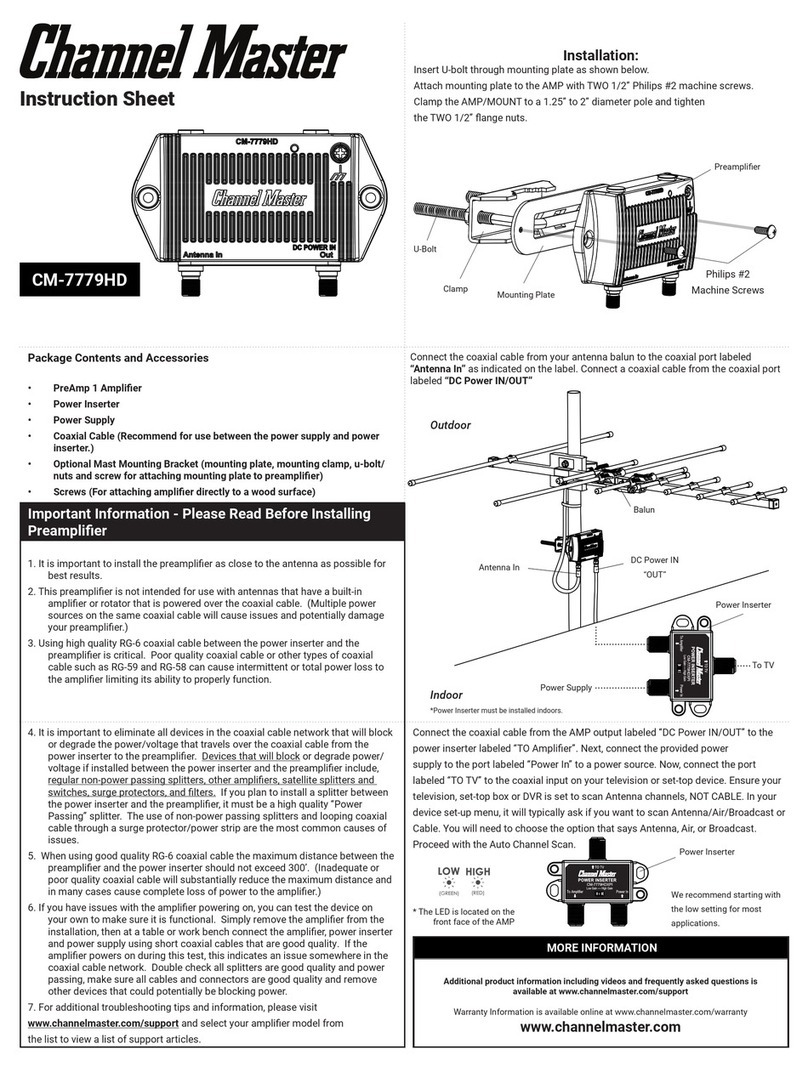
Channel Master
Channel Master CM-7779HD User manual

Channel Master
Channel Master CM-1776 User manual

Channel Master
Channel Master Off-Air Antenna User manual
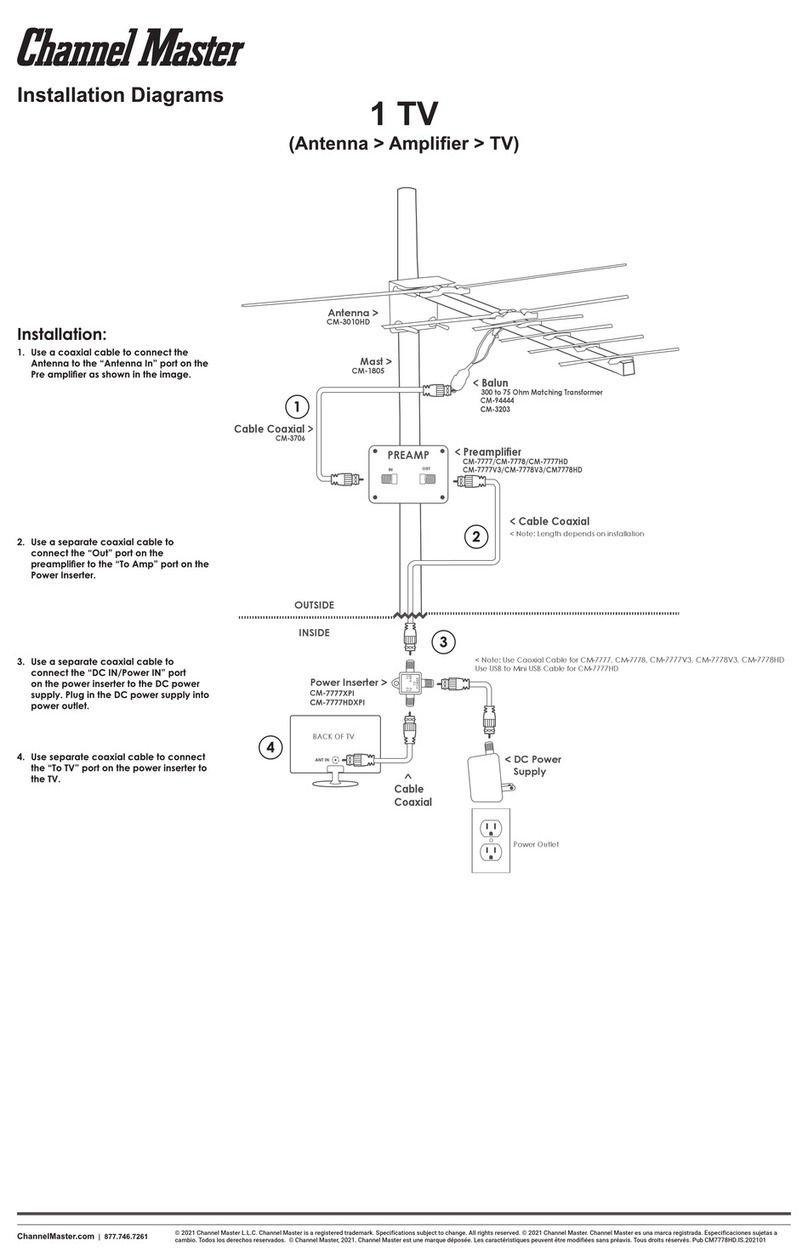
Channel Master
Channel Master 1 TV User manual

Channel Master
Channel Master CM-3202 User manual
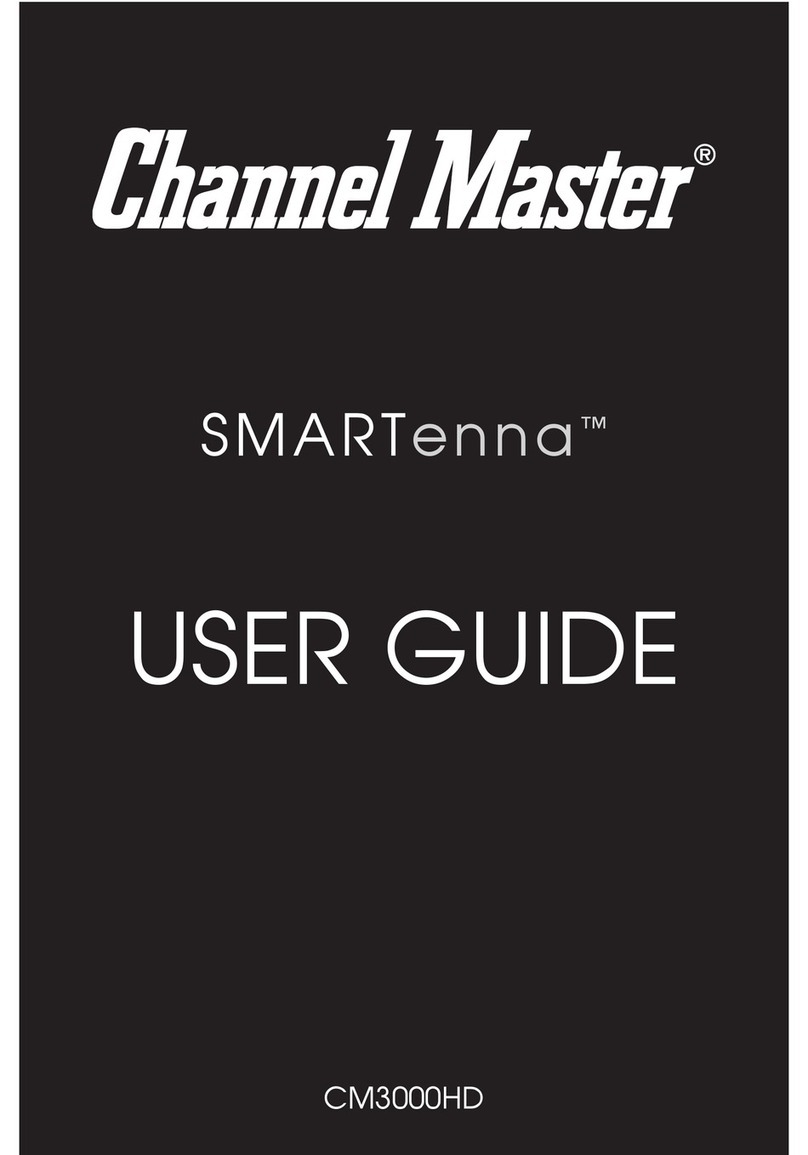
Channel Master
Channel Master CM-3000HD User manual

Channel Master
Channel Master FLATenna User manual
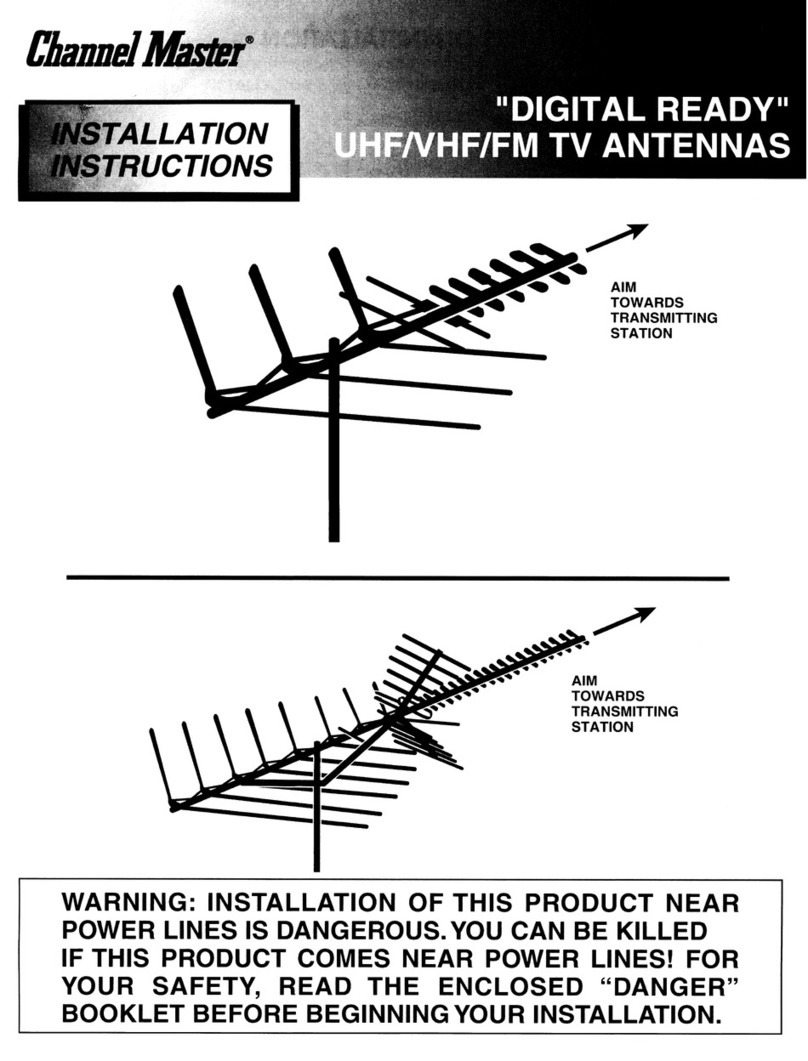
Channel Master
Channel Master Digital ready User manual
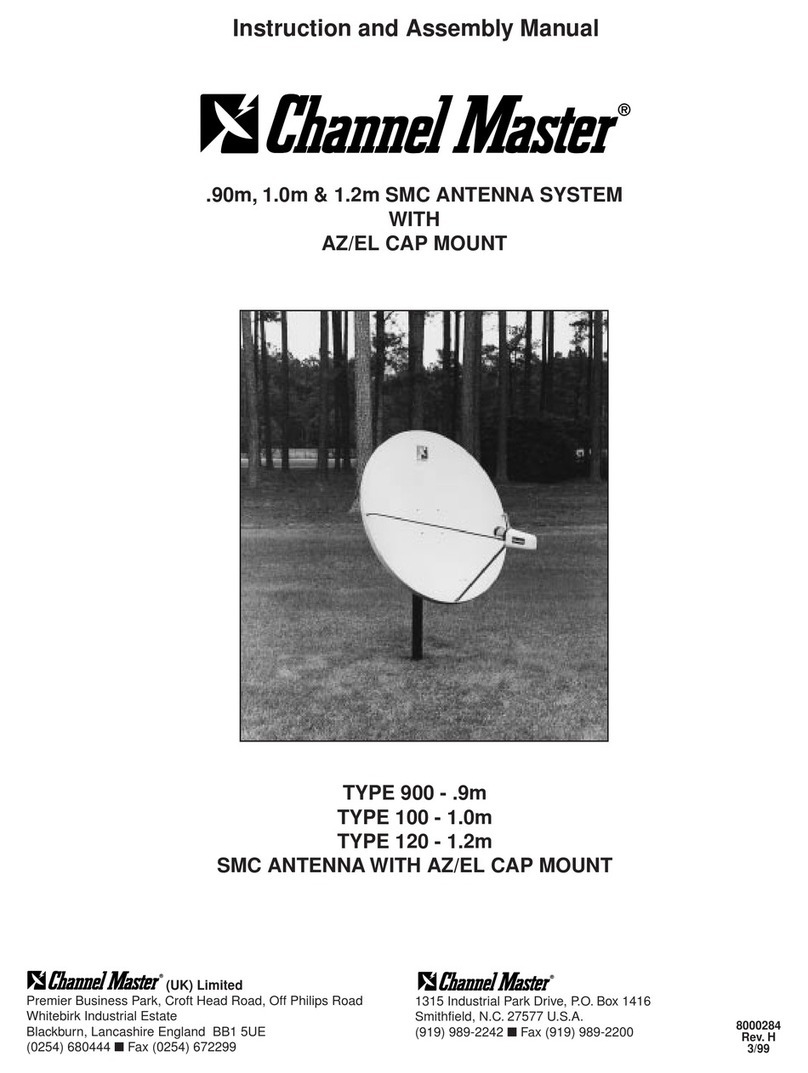
Channel Master
Channel Master 100 User manual
